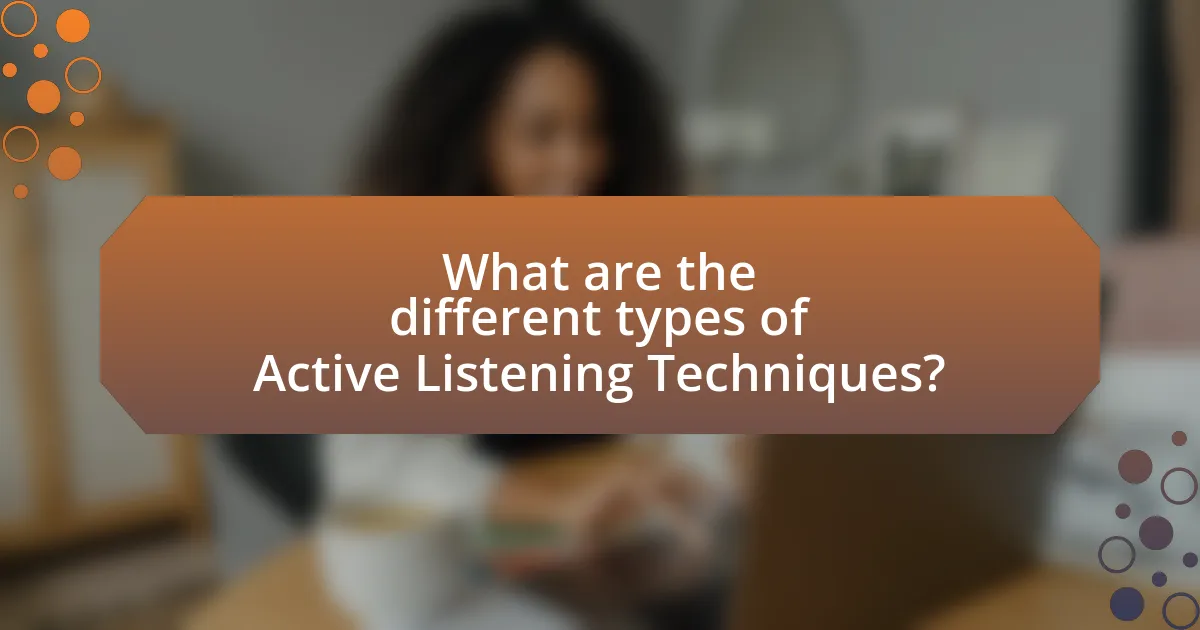Active listening techniques for coaches are essential tools that enhance client engagement and communication. Key techniques include paraphrasing, summarizing, asking open-ended questions, and providing reflective feedback, all of which foster a deeper understanding and trust between the coach and client. The article explores how these techniques improve client satisfaction and outcomes, the components that contribute to effective coaching, and the challenges coaches face in practicing active listening. Additionally, it discusses strategies for implementing these techniques, measuring their effectiveness, and creating a conducive environment for open communication, supported by research findings that highlight the importance of active listening in coaching relationships.

What are Active Listening Techniques for Coaches?
Active listening techniques for coaches include paraphrasing, summarizing, asking open-ended questions, and providing reflective feedback. Paraphrasing involves restating what the client has said in your own words to confirm understanding, while summarizing captures the main points of the conversation to ensure clarity. Asking open-ended questions encourages clients to explore their thoughts and feelings more deeply, fostering engagement. Reflective feedback allows coaches to mirror the client’s emotions and thoughts, validating their experiences. These techniques enhance communication and build trust, which are essential for effective coaching relationships.
How do Active Listening Techniques enhance client engagement?
Active listening techniques enhance client engagement by fostering a deeper connection and understanding between the coach and the client. These techniques, such as reflecting, paraphrasing, and asking open-ended questions, encourage clients to express their thoughts and feelings more freely, leading to increased trust and rapport. Research indicates that effective communication, which includes active listening, can improve client satisfaction and outcomes, as clients feel heard and valued. For instance, a study published in the Journal of Counseling Psychology found that clients who perceived their counselors as actively listening reported higher levels of engagement and commitment to the therapeutic process.
What are the key components of Active Listening Techniques?
The key components of Active Listening Techniques include paying full attention, demonstrating understanding, providing feedback, and withholding judgment. Paying full attention involves focusing entirely on the speaker, which enhances the connection and shows respect. Demonstrating understanding can be achieved through verbal affirmations and non-verbal cues, such as nodding, which signal engagement. Providing feedback, such as paraphrasing or summarizing what the speaker has said, confirms comprehension and encourages further dialogue. Withholding judgment means refraining from forming opinions or responses until the speaker has fully expressed their thoughts, fostering a safe environment for open communication. These components are essential for effective coaching, as they enhance client engagement and facilitate deeper conversations.
How do these components contribute to effective coaching?
Active listening techniques contribute to effective coaching by fostering deeper client engagement and understanding. These techniques, such as reflecting, paraphrasing, and asking open-ended questions, enable coaches to fully comprehend clients’ thoughts and feelings, which enhances the coaching relationship. Research indicates that effective communication, including active listening, leads to improved client outcomes, as it builds trust and encourages clients to share more openly, ultimately facilitating personal growth and goal achievement.
Why is Active Listening important in coaching?
Active listening is important in coaching because it fosters a deeper understanding between the coach and the client, enhancing the effectiveness of the coaching process. By actively engaging with clients through attentive listening, coaches can accurately interpret their needs, emotions, and perspectives, which leads to more tailored and impactful guidance. Research indicates that effective communication, including active listening, significantly improves client satisfaction and outcomes in coaching relationships, as it builds trust and rapport, essential components for successful coaching.
What impact does Active Listening have on client relationships?
Active listening significantly enhances client relationships by fostering trust and understanding. When coaches actively listen, they demonstrate genuine interest in clients’ thoughts and feelings, which leads to improved communication and rapport. Research indicates that effective listening can increase client satisfaction and loyalty, as clients feel valued and understood. A study published in the Journal of Counseling Psychology found that clients who perceive their counselors as good listeners report higher levels of therapeutic alliance, which is crucial for successful outcomes. This evidence underscores the importance of active listening in building strong, effective client relationships.
How does Active Listening influence client outcomes?
Active listening significantly enhances client outcomes by fostering trust and understanding in the coaching relationship. When coaches practice active listening, they demonstrate empathy and validate clients’ feelings, which leads to increased client engagement and satisfaction. Research indicates that effective communication, including active listening, can improve therapeutic outcomes by up to 30%, as clients feel more heard and valued. This heightened sense of connection encourages clients to share more openly, facilitating deeper exploration of their challenges and goals, ultimately leading to more effective coaching interventions.

What are the different types of Active Listening Techniques?
The different types of active listening techniques include reflective listening, paraphrasing, summarizing, and asking open-ended questions. Reflective listening involves restating what the speaker has said to confirm understanding, which fosters trust and clarity. Paraphrasing requires the listener to rephrase the speaker’s message in their own words, demonstrating comprehension and engagement. Summarizing condenses the main points of the conversation, allowing both parties to clarify and align on key ideas. Asking open-ended questions encourages deeper exploration of the topic, prompting the speaker to elaborate and share more insights. These techniques enhance communication effectiveness and client engagement in coaching scenarios.
How can coaches implement these techniques in their practice?
Coaches can implement active listening techniques in their practice by incorporating specific strategies such as paraphrasing, summarizing, and asking open-ended questions during client interactions. Paraphrasing allows coaches to reflect back what clients have said, ensuring understanding and validating their feelings. Summarizing helps to consolidate information and clarify key points, which enhances communication. Additionally, asking open-ended questions encourages clients to express themselves more fully, fostering deeper engagement. Research indicates that these techniques significantly improve client satisfaction and outcomes, as evidenced by a study published in the Journal of Coaching Psychology, which found that effective listening skills correlate with higher levels of client trust and rapport.
What are some practical examples of Active Listening Techniques?
Practical examples of active listening techniques include paraphrasing, summarizing, asking open-ended questions, and using non-verbal cues. Paraphrasing involves restating what the speaker has said in your own words to confirm understanding, which enhances clarity and shows attentiveness. Summarizing condenses the main points of the conversation, allowing the speaker to see their thoughts organized, which can lead to deeper insights. Asking open-ended questions encourages the speaker to elaborate on their thoughts and feelings, fostering a more engaging dialogue. Non-verbal cues, such as nodding and maintaining eye contact, signal to the speaker that you are fully present and engaged, reinforcing the connection between the listener and the speaker. These techniques are supported by research indicating that effective active listening improves communication and strengthens relationships, particularly in coaching contexts.
How do these techniques vary based on client needs?
Active listening techniques vary based on client needs by adapting the approach to individual communication styles, emotional states, and specific goals. For instance, some clients may require more empathetic responses to feel understood, while others might benefit from direct questioning to clarify their thoughts. Research indicates that tailoring communication strategies enhances client engagement and satisfaction, as evidenced by a study published in the Journal of Coaching Psychology, which found that personalized listening techniques significantly improved client outcomes.
What challenges do coaches face in practicing Active Listening?
Coaches face several challenges in practicing Active Listening, primarily including distractions, emotional biases, and time constraints. Distractions can arise from external environments or internal thoughts, making it difficult for coaches to fully focus on their clients. Emotional biases may lead coaches to interpret messages through their own experiences rather than understanding the client’s perspective. Additionally, time constraints often pressure coaches to rush conversations, hindering their ability to engage in deep listening. Research indicates that effective listening requires a significant investment of time and mental energy, which can be challenging in fast-paced coaching environments.
How can coaches overcome barriers to effective listening?
Coaches can overcome barriers to effective listening by actively practicing techniques such as maintaining eye contact, using open body language, and summarizing what clients say to ensure understanding. These techniques help create an environment conducive to open communication, allowing coaches to better grasp clients’ needs and concerns. Research indicates that active listening improves client satisfaction and engagement, as demonstrated in a study published in the Journal of Counseling Psychology, which found that effective listening skills significantly enhance the therapeutic alliance between coaches and clients.
What strategies can enhance a coach’s listening skills?
To enhance a coach’s listening skills, implementing active listening techniques is essential. These techniques include maintaining eye contact, using verbal affirmations, and summarizing what the client has said to ensure understanding. Research indicates that active listening fosters a stronger coach-client relationship, leading to improved engagement and outcomes. For instance, a study published in the Journal of Coaching Education highlights that coaches who practice active listening techniques report higher satisfaction levels among clients, demonstrating the effectiveness of these strategies in enhancing listening skills.

How can coaches measure the effectiveness of Active Listening Techniques?
Coaches can measure the effectiveness of Active Listening Techniques through client feedback, observation of client engagement, and tracking progress towards goals. Client feedback can be gathered through surveys or informal discussions, allowing coaches to assess how well clients feel heard and understood. Observation of client engagement during sessions, such as body language and responsiveness, provides insight into the impact of listening techniques. Additionally, tracking progress towards specific goals can indicate whether effective listening has facilitated better communication and understanding, ultimately leading to improved outcomes. Research shows that effective listening correlates with higher client satisfaction and engagement, reinforcing the importance of these techniques in coaching.
What tools or methods can be used for assessment?
Tools and methods for assessment in the context of active listening techniques for coaches include structured feedback forms, observational assessments, and self-reflection journals. Structured feedback forms allow clients to evaluate their coaching experience and the effectiveness of active listening techniques, providing quantifiable data for coaches. Observational assessments involve coaches evaluating their own listening skills during sessions, often using a checklist to identify strengths and areas for improvement. Self-reflection journals enable coaches to document their experiences and insights, fostering personal growth and enhancing their listening abilities. These methods are validated by research indicating that reflective practices and feedback mechanisms significantly improve coaching effectiveness and client engagement.
How can feedback from clients inform listening practices?
Feedback from clients can significantly inform listening practices by providing insights into their needs, preferences, and perceptions. When clients share their experiences, coaches can identify specific areas where their listening may be lacking or effective. For instance, a study published in the Journal of Coaching Psychology found that coaches who actively sought client feedback improved their ability to engage and respond to client concerns, leading to enhanced coaching outcomes. This evidence demonstrates that integrating client feedback into listening practices not only fosters a more responsive coaching environment but also strengthens the overall client-coach relationship.
What metrics indicate improved client engagement?
Metrics that indicate improved client engagement include increased session attendance, higher client retention rates, and enhanced feedback scores. Increased session attendance reflects clients’ commitment and interest in the coaching process, while higher retention rates suggest satisfaction and perceived value in the coaching relationship. Enhanced feedback scores, often gathered through surveys, provide quantitative data on clients’ experiences and their likelihood to recommend the coaching services. For instance, a study by the International Coach Federation found that clients who felt more engaged reported a 70% higher satisfaction rate, demonstrating a clear correlation between these metrics and client engagement levels.
What are best practices for implementing Active Listening Techniques?
Best practices for implementing Active Listening Techniques include maintaining eye contact, providing verbal affirmations, and summarizing the speaker’s points. Maintaining eye contact demonstrates attentiveness and encourages open communication, while verbal affirmations like “I see” or “Go on” signal engagement. Summarizing the speaker’s points ensures understanding and shows that the listener values the speaker’s message. Research indicates that these techniques enhance client engagement and foster a trusting relationship, which is crucial for effective coaching.
How can coaches create a conducive environment for Active Listening?
Coaches can create a conducive environment for Active Listening by establishing trust and demonstrating empathy. Trust is built through consistent, respectful interactions, which encourage clients to share openly. Empathy is shown by acknowledging clients’ feelings and perspectives, making them feel valued and understood. Research indicates that environments fostering psychological safety, where clients feel free to express themselves without fear of judgment, significantly enhance engagement and communication effectiveness. For instance, a study published in the Journal of Applied Psychology found that leaders who promote open dialogue and active engagement improve team performance and satisfaction, underscoring the importance of a supportive atmosphere for Active Listening.
What ongoing training or resources can support coaches in this area?
Ongoing training and resources that can support coaches in enhancing active listening techniques include workshops, online courses, and professional coaching certifications focused on communication skills. For instance, the International Coach Federation (ICF) offers accredited programs that emphasize active listening as a core competency. Additionally, resources such as the book “Coaching with the Brain in Mind” by David Rock and Linda J. Page provide insights into effective listening strategies backed by neuroscience. These training opportunities and materials are designed to improve coaches’ abilities to engage clients effectively, thereby fostering better communication and understanding in coaching relationships.
